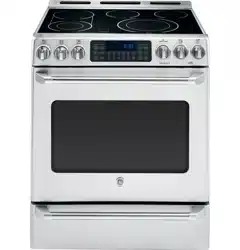Documents: Go to download!
- Owner's manual - (English, Spanish)
- USING THE COOKTOP
- CARE AND CLEANING
- Troubleshooting tips ... Before you call for service
Table of contents
User Manual
USING THE COOKTOP
Surface Burners
How to Remove Protective Shipping Film and Packaging Tape
Carefully grasp a corner of the protective shipping film with your fingers and slowly peel it from the appliance surface. Do not use any sharp items to remove the film. Remove all of the film before using the appliance for the first time.
To assure no damage is done to the finish of the product, the safest way to remove the adhesive from packaging tape on new appliances is an application of a household liquid dishwashing detergent. Apply with a soft cloth and allow to soak.
NOTE: The adhesive must be removed from all parts. It cannot be removed if it is baked on.
How to Light a Surface Burner
WARNING: Burners should be operated only when covered by cookware. Burner flames not covered by cookware present a risk of fire or clothing ignition. Never let flames extend beyond the sides of the cookware. Failure to comply may result in serious injury.
Make sure all burners are in their correct locations and fully assembled before attempting to operate any burner.
Select a burner and find its control knob. Push the knob in and turn it to the LITE position.
You will hear a clicking noise— the sound of the electric spark igniting the burner. When one burner is turned to LITE, all burners will spark. Sparking will continue as long as the knob remains at LITE. Once gas is ignited, turn the knob to adjust the flame size.
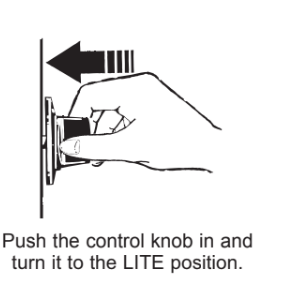
After Lighting a Burner
- Do not operate the burner for an extended period oftime without cookware on the grate. The finish on the grate may discolor or chip without cookware to absorb the heat.
- Do not attempt to disassemble any burner while another burner is on. An electric shock may result, which could cause you to knock over hot cookware.
- Be sure the burners and grates are cool before you place your hand, a pot holder or cleaning materials on them.
Use of the Surface Burners
Your gas rangetop has sealed gas burners. They offer convenience, cleanability and flexibility for a wide range of cooking applications.
The smallest burner is the simmer burner. On some models, the center burner of the triple flame burner provides an additional simmer burner. A simmer burner turned down to LO provides precise cooking performance for foods such as delicate sauces that require low heat for a long cooking time.
The extra-large burner is designed to quickly bring large amounts of liquid to a boil. Some models have a POWER BOIL™ setting especially designed for use with cookware with a diameter of 11 inches or larger.
How to Select Flame Size
Watch the flame, not the knob, as you adjust heat. When rapid heating is desired, the flame size on a burner should match the size of the cookware you are using. Flames larger than the bottom of the cookware will not heat faster and may be hazardous.
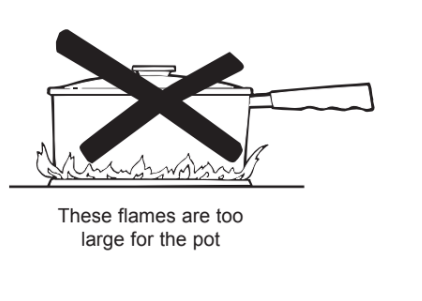
Top-of-Range Cookware
Aluminum: Medium-weight cookware is recommended because it heats quickly and evenly. Most foods brown evenly in an aluminum skillet. Use saucepans with tight-fitting lids when cooking with minimum amounts of water.
Stainless Steel: This metal alone has poor heating properties and is usually combined with copper, aluminum or other metals for improved heat distribution. Combination metal skillets usually work satisfactorily if they are used with medium heat as the manufacturer recommends.
Cast-Iron: If heated slowly, most skillets will give satisfactory results.
Enamelware: Under some conditions, the enamel of some cookware may melt. Follow cookware manufacturer’s recommendations for cooking methods.
Glass: There are two types of glass cookware—those for oven use only and those for top-of-range cooking (saucepans, coffee and teapots). Glass conducts heat very slowly.
Heatproof Glass Ceramic: Can be used for either surface or oven cooking. It conducts heat very slowly and cools very slowly. Check cookware manufacturer’s directions to be sure it can be used on gas ranges.
Stove Top Grills
Do not use an after-market stove top grill on your gas surface burners. A stove top grill will cause incomplete combustion resulting in carbon monoxide levels above allowable standards. This could be hazardous to your health.

Using a Wok
Use only a flat-bottomed wok with a diameter of 14 inches or less. Make sure the wok bottom sits flat on the grate.
Do not use a wok support ring. Placing the ring over the burner or grate may cause the burner to work improperly, resulting in carbon monoxide levels above allowable standards. This could be hazardous to your health.
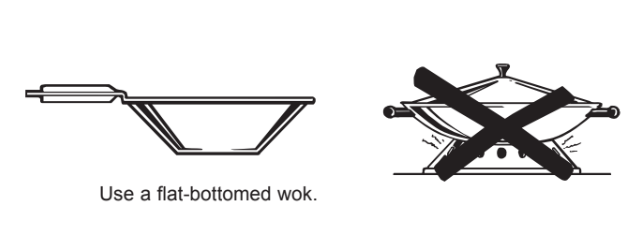
In Case of a Power Failure
In case of a power failure, you can light the surface Surface burners in use when an electrical power failure burners on your range with a match. Hold a lit match occurs will continue to operate normally. to the burner ports, then slowly turn the control knob to the LITE position. Use extreme caution when lighting burners this way.
Griddle
Using the Griddle
WARNING: Fire Hazard
- The PREHEAT setting (on some models) is provided to quickly heat your griddle. Turn heat down before placing food on the griddle. Cooking at the PREHEAT setting may result in fire.
- Use care when cooking greasy foods. Spilled grease may result in fire.
- Never place any items on the griddle when it is not in use. Heat from surrounding burners can heat the griddle and may result in fire.
- Place and remove the griddle only when griddle is cool and all surface burners are turned OFF.
Your griddle provides an extra-large cooking surface for meats, pancakes and other foods usually prepared in a skillet. Before first use, rinse with hot water and dry thoroughly. Prepare the surface with cooking spray or vegetable oil.
NOTE: Do not place the griddle in a microwave oven.
NOTE: Do not clean the griddle in the self-cleaning oven. Doing so will remove the seasoned finish. For instructions on how to clean the griddle, see Care and Cleaning section.
Placement of the Nonstick Griddle on the Cooktop
These griddles can only be used over the oval burner in the center of the rangetop. To position the griddle, remove the center grate and replace it with the griddle. Do not turn on the oval burner until you are certain the griddle has been positioned correctly.
Preheating the griddle - Preheat for 5-10 minutes before placing food on griddle and then turn heat down to cook setting.
Nonstick Griddle
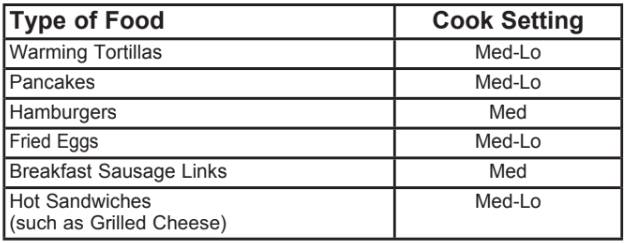
Do not overheat the griddle. Leaving the griddle burner on at HI for an extended amount of time without food can damage the nonstick coating.
Avoid using metal utensils with sharp points or rough sharp edges which might
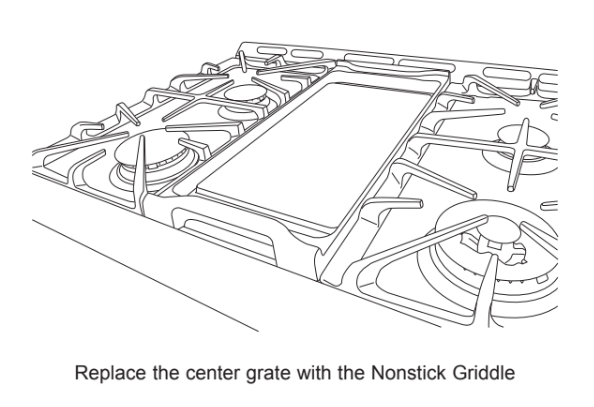
Oven Controls
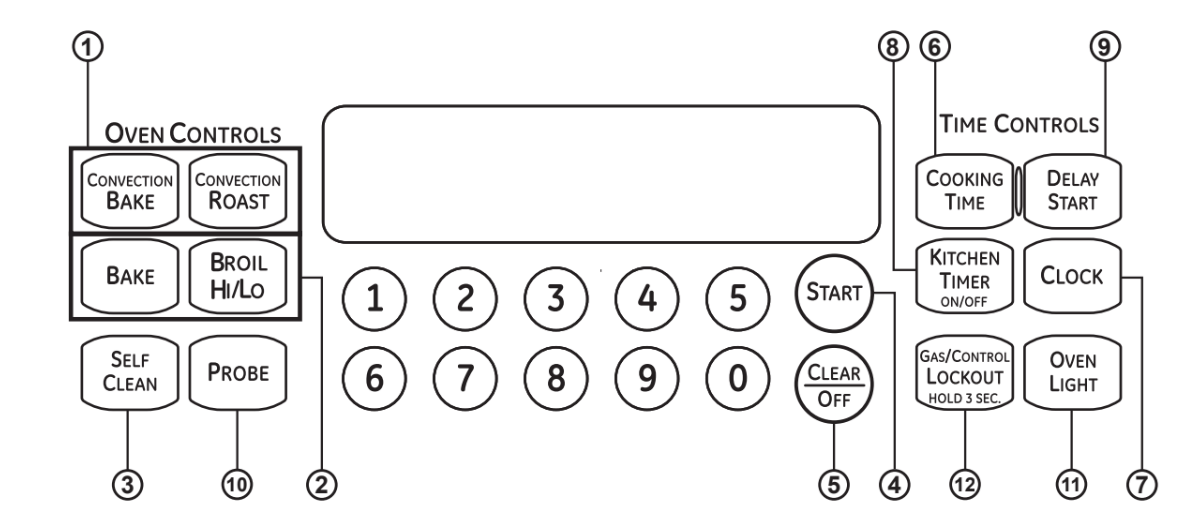
1. Convection Cooking Modes: Convection cooking modes use increased air circulation to improve performance. The type of benefit depends on the mode. Your oven has the following convection cooking modes: Bake and Roast. See the Cooking Modes section for more information.
2. Traditional Cooking Modes: Your oven has the following traditional cooking modes: Bake and Broil Hi/Lo. See the Cooking Modes section for more information.
3. Clean: Your oven has a Self Clean mode. See the Cleaning the Oven section for important information about using this mode.
4. Start: Must be pressed to start any cooking, cleaning, or timed function.
5. Clear/Off: Cancels ALL oven operations except the clock and timer.
6. Cooking Time: Counts down cooking time and turns off the oven when the cooking time is complete. Press the Cooking Time pad, use the number pads to program a cooking time in hours and minutes, then press Start. This can only be used with Traditional Bake, Convection Bake and Convection Roast.
7. Clock: Sets the oven clock time. Press Clock pad. Use the number pads to program the clock. Press Start to save the time.
8. Kitchen Timer: Works as a countdown timer. Press the Kitchen Timer pad and the number pads to program the time in hours and minutes. Press the Start pad. The oven will continue to operate when the timer countdown is complete. To turn the timer off press the Kitchen Timer pad.
9. Delay Start: Delays when the oven will turn on. Use this to set a time when you want the oven to start. Press the Delay Time pad and use the number pads to program the time of day for the oven to turn on then press Start. Press the desired cooking mode and temperature then press Start. A cook time may also be programmed if desired. This can only be used with Traditional Bake, Convection Bake, Convection Roast and Self-Clean.
NOTE: When using the delay time feature, foods that spoil easily—such as milk, eggs, fish, stuffings, poultry and pork—should not be allowed to sit for more than 1 hour before or after cooking. Room temperature promotes the growth of harmful bacteria Be sure that the oven light is off because heat from the bulb will speed harmful bacteria growth.
10. Probe: Monitors internal food temperature and turns the oven off when the food reaches the programmed temperature. Insert the probe, program the cooking mode, and program the probe temperature. See the Cooking Modes section for more information. The probe can only be used with Traditional Bake and Convection Roast.
11. Oven Light: Turns the oven light on or off.
12. Gas/Control Lockout: Touch and hold the Gas/Control Lockout pad for 3 seconds to lock/ unlock the surface burners, oven burners and control panel so they cannot be activated.
Oven Air Vents
Never block the vents (air openings) of the range. They provide the air inlet and outlet that are necessary for the range to keep cool and operate properly with correct combustion.
Air openings are located at the rear of the cooktop, at the top and bottom of the oven door, and at the bottom of the range.
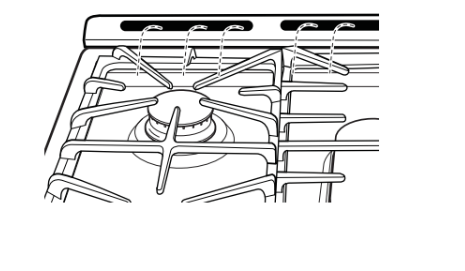
Special Features
There are several different special features on your oven. To change the settings of these special features, press the Bake and Broil pads at the same time and hold for three seconds. (SF) will appear in the display. Select the feature you want to change. When the change has been made, press the Start key to save the change and return to the time of day.
Adjust the Oven Temperature
This feature allows the oven baking temperature to be adjusted up to 35°F hotter or down to 35°F cooler. Use this feature if you believe your oven temperature is too hot or too cold and wish to change it.
Press the Bake pad to enter the temperature adjustment mode. A number between 35 and - 35 will display. Use the number pads to set the desired temperature adjustment and use the Bake pad to change between negative and positive.
Press the Start pad to save the temperature adjustment.
End of Timer Signals
This is the tone that signals the end of a timer. The tone can be continuous (Con bEEp) or one repeating beep (bEEp). A continuous setting will continue to sound a tone until a button on the control is pressed. Press the Kitchen Timer pad to view the current setting and then to change the setting.
Fahrenheit or Celsius Temperature Display
The oven control is set to use Fahrenheit temperatures (F), but you can change it to use Celsius temperatures (C). Press the Broil and Cook Time pads at the same time to view the current setting, press again to change the setting.
Clock Display
This feature specifies how the time of day will be displayed or if no time of day will be displayed. You can select a standard 12-hour clock (12 hr), 24-hour military time display (24 hr), or no clock displayed (OFF). Press the Clock pad to view the current setting, press again to change the setting.
Autorecipe Conversion
This feature (ON/OFF), automatically reduces the programmed recipe temperature in Convection Bake mode by 25°F. The default setting for this feature is off.
Note: This option does not convert baking time, only temperatures. This option does not adjust temperatures for Convection Roast mode. Press either Bake or Roast to view the current setting. Press again to change the setting.
Using the Sabbath Feature
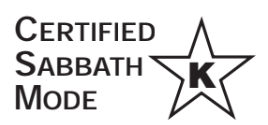
(Designed for use on the Jewish Sabbath and Holidays)
The Sabbath feature can be used for baking in the upper and lower oven or baking drawer (on some models). It cannot be used for convection, broiling, selfcleaning or Delay Start cooking.
NOTE: The oven light comes on automatically when the door is opened and goes off when the door is closed. The bulb may be removed. See the Oven Light Replacement section. On models with a light switch on the control panel, the oven light may be turned on and left on.
How to Set for Regular Baking:
Make sure the clock shows the correct time of day and the oven is off.
- Press and hold both the Bake and Broil Hi/Lo pads, at the same time, until the display shows (SF).
- Tap the Delay Start pad until (SAb bAtH) appears in the display.
- Touch the Start pad and (3) will appear in the display.
- Touch the Bake pad. No signal will be given.
- Using the number pads, enter the desired temperature between 170° and 550°. No signal or temperature will be given.
- Touch the Start pad.
- After a random delay period of approximately 30 seconds to 1 minute, (
 ) will appear in the display, indicating that the oven is baking. If (
) will appear in the display, indicating that the oven is baking. If ( ) doesn't appear in the display, start again at Step 4.
) doesn't appear in the display, start again at Step 4.
To adjust the oven temperature, touch the Bake pad, enter the new temperature using the number pads and touch the Start pad.
NOTE: The Clear/Off and Cooking Time pads are active during the Sabbath feature.
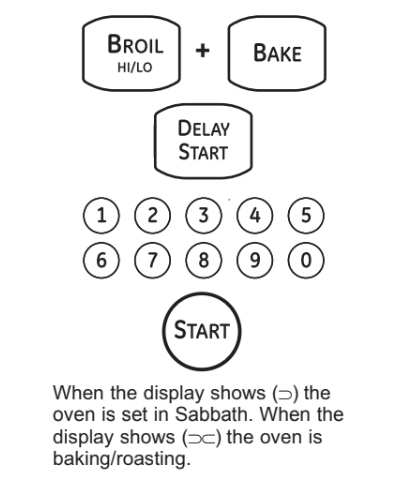
How to Set for Timed Baking-Immediate Start and Automatic Stop:
Make sure the clock shows the correct time of day and the oven is off.
- Press and hold both the Bake and Broil Hi/Lo pads, at the same time, until the display shows (SF).
- Tap the Delay Start pad until (SAb bAtH) appears in the display.
- Touch the Start pad and (
 ) will appear in the display.
) will appear in the display. - Touch the Cooking Time pad.
- Touch the number pads to set the desired length of cooking time between 1 minute and 9 hours and 99 minutes. The cooking time that you entered will be displayed.
- Touch the Start pad.
- Touch the Bake pad. No signal will be given.
- Using the number pads, enter the desired temperature. No signal or temperature will be given.
- Touch the Start pad.
- After a random delay period of approximately 30 seconds to 1 minute, (
 ) will appear in the display, indicating that the oven is baking/roasting. If (
) will appear in the display, indicating that the oven is baking/roasting. If ( ) doesn’t appear in the display, start again at Step 7.
) doesn’t appear in the display, start again at Step 7.
To adjust the oven temperature, touch the Bake pad, enter the new temperature using the number pads and touch the Start pad.
When cooking is finished, the display will change from ( ) to (
) to ( ) and (0:00) will appear, indicating that the oven has turned OFF but is still set in Sabbath. Remove the cooked food.
) and (0:00) will appear, indicating that the oven has turned OFF but is still set in Sabbath. Remove the cooked food.
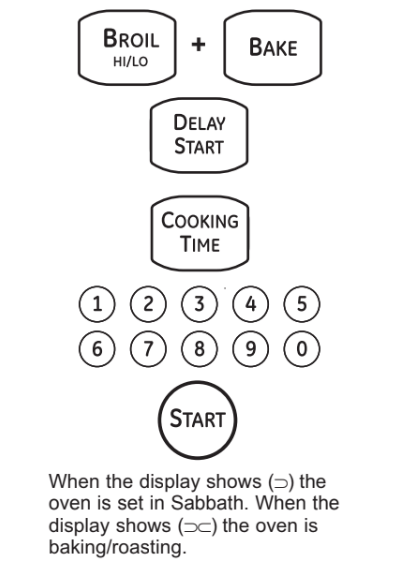
How to Exit the Sabbath Feature:
- Touch the Clear/Off pad.
- If the oven is cooking, wait for a random delay period of approximately 30 seconds to 1 minute, until only (
 ) is in the display.
) is in the display. - Press and hold both the Bake and Broil Hi/Lo pads, at the same time, until the display shows (SF).
- Tap the Delay Start pad until (12 shdn) or (no shdn) appears in the display. (12 shdn) indicates that the oven will automatically turn off after 12 hours, (no shdn) indicates that the oven will not automatically turn off.
- Touch the Start pad.
NOTE: If a power outage occurred while the oven was in Sabbath, the oven will automatically turn off and stay off even when the power returns. The oven control must be reset.
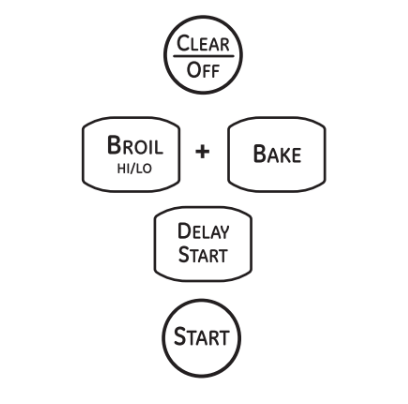
Oven Racks
Your oven has six rack positions. Recommended rack positions for various types of foods are provided in the Cooking Guide. Adjusting rack position is one way to impact cooking results. For example, if you would prefer darker tops on cakes, muffins, or cookies, try moving food one rack position higher. If you find foods are too brown on top try moving them down next time.
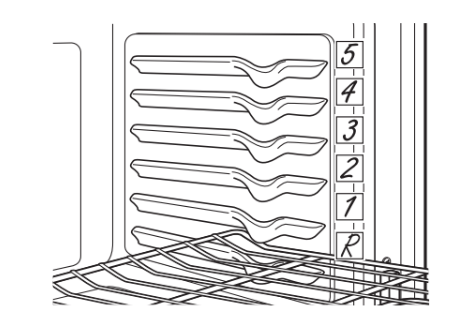
When baking with multiple pans and on multiple racks, ensure there is sufficient space between pans to allow air to flow.
Flat Racks
When placing and removing cookware, pull the rack out to the bump (stop position) on the rack support.
To remove a rack, pull it toward you, tilt the front end up and pull it out.
To replace, place the curved end of the rack (stop-locks) onto the oven supports, tilt up the front of the rack and push the rack in.
Racks may become difficult to slide, especially after a self-clean. Put some vegetable oil on a soft cloth or paper towel and rub onto the left and right edges.
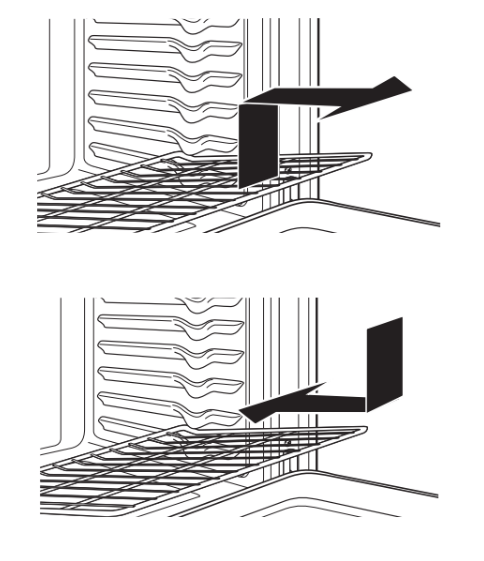
Cookware
Cookware Guidelines
The material, finish, and size of cookware affect baking performance.
Dark, coated and dull pans absorb heat more readily than light, shiny pans. Pans that absorb heat more readily can result in a browner, crisper, and thicker crust. If using dark and coated cookware check food earlier than minimum cook time. If undesirable results are obtained with this type of cookware consider reducing oven temperature by 25° F next time.
Shiny pans can produce more evenly cooked baked goods such as cakes and cookies.
Glass and ceramic pans heat slowly but retain heat well. These types of pans work well for dishes such as pies and custards.
Air insulated pans heat slowly and can reduce bottom browning.
Keep cookware clean to promote even heating.
Cooking Modes
Your new oven has a variety of cooking modes to help you get the best results. These modes are described below. Refer to the Cooking Guide section for recommendations for specific foods. Remember, your new oven may perform differently than the oven it is replacing.
Bake
The bake mode is for baking and roasting. This mode uses heat primarily from the lower burner but also from the upper burner to cook food. When preparing baked goods such as cakes, cookies, and pastries always preheat the oven first. Follow recipe recommendations for food placement. If no guidelines are provided center food in the oven. To use this mode press the Bake pad, enter a temperature, and then press Start.
Broiling Modes
Always broil with the door closed. Monitor food closely while broiling. Use caution when broiling on upper rack positions as placing food closer to the broil burner increases smoking, spattering, and the possibility of fats igniting.
Try broiling foods that you would normally grill. Adjust rack positions to adjust the intensity of the heat to the food. Place foods closer to the broil burner when a seared surface and rare interior is desired. Thicker foods and foods that need to be cooked through should be broiled on a rack position farther from the burner or by using Broil Lo.
Broil Hi
The Broil Hi mode uses intense heat from the upper burner to sear foods. Use Broil Hi for thinner cuts of meat and/ or foods you prefer less done on the interior. To use this mode press the Broil pad once and then press Start. It is not necessary to preheat when using this mode.
Broil Lo
The Broil Lo mode uses less intense heat from the upper burner to cook food thoroughly while also browning the surface. Use Broil Lo for thicker cuts of meat and/or foods that you would like cooked all the way through. To use this mode press the Broil pad twice and then press Start. It is not necessary to preheat when using this mode.
Convection Bake
The Convection Bake mode is intended for baking on a single rack. This mode may use heat from the upper and lower burners, along with air movement from the convection fan to enhance cooking evenness. Your oven is equipped with Auto Recipe Conversion, so it is not necessary to convert the temperature when using this mode. To use this mode press the Bake pad under Convection, enter a temperature, and then press Start. Always preheat when using this mode.
Convection Roast
The Convection Roast mode is intended for roasting whole cuts of meat on a single rack. This mode may use heat from the upper and lower bake burner along with air movement to improve browning and reduce cooking time. It is not necessary to convert temperature. Check food earlier than the recipe suggested time when using this mode, or use the probe (on some models). To use this mode press the Roast pad under Convection, enter a temperature, and then press Start. It is not necessary to preheat when using this mode.
Probe
Internal food temperature is frequently used as an indicator of doneness, especially for roasts and poultry. The Probe mode monitors the internal food temperature and turns the oven off when the internal food temperature reaches the programmed temperature.
Minimum temperatures for food safety can be found at www.lsltDoneYet.gov. The temperature probe can only be used with Traditional Bake, Convection Bake, and Convection Roast modes.
To use the probe with preheating:
- Press the desired cook mode (Traditional Bake, Convection Bake, or Convection Roast) pad and enter the desired cooking temperature.
- Insert the probe into the food (see Proper Probe Placement Guidelines in this section).
- Once the oven is preheated, place the food in the oven and connect the probe to the probe outlet, making sure it is fully inserted. Use caution, the oven walls and probe outlet are hot.
- Program the probe temperature by pressing the Probe pad and entering the desired food temperature. The maximum internal food temperature that you can set is 200° F.
Using the Lower Oven Drawer
The lower oven drawer may be used to bake foods using the same times and temperatures as a standard oven. Foods ideal for baking in the lower oven drawer include pizza, frozen foods, casseroles, biscuits, rolls and many desserts.
To Use the Lower Oven Drawer
- Push in and turn the lower oven drawer knob to any desired setting.
- Allow the lower oven drawer to preheat.
- The ON signal light is located on the upper right side of the knob and glows when the knob is in the ON position. It remains ON until the knob is moved to the OFF position.
- The “Heating” signal light is located below the ON signal light and glows when the heating elements are active. Preheat is complete after the “Heating” signal has turned off for the first time each use.
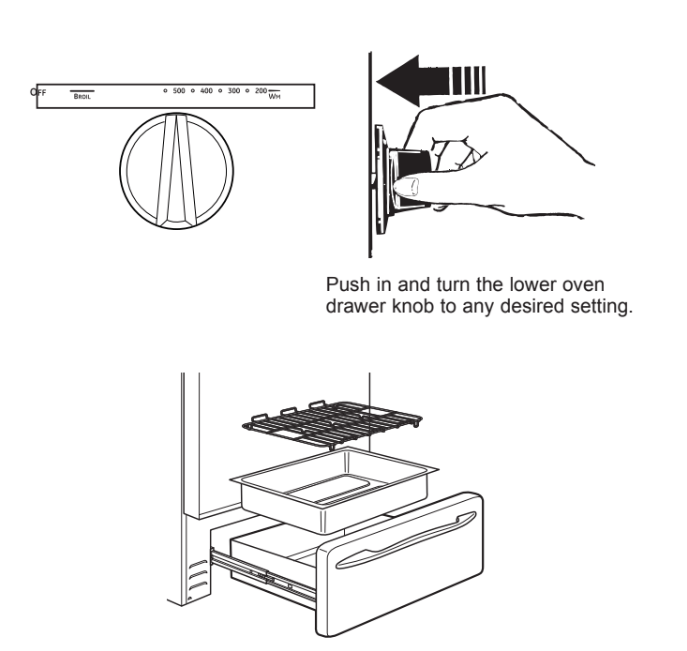
NOTES:
- Always use the included drawer rack when using the lower oven drawer.
- The lower oven drawer cannot be used during a self-clean cycle of the upper oven.
- Do not put food, foil or cookware directly on the bottom of the lower oven drawer. Always use the included drawer rack.
- If foods require a cover, use only foil or lids able to withstand baking temperatures. Do not use plastic.
- Maximum height of foods that can be placed in the lower oven drawer is 4”.
- Do not put liquid or water in the lower oven drawer.
- Never place plastics, paper, canned foods or combustible material in the lower oven drawer.
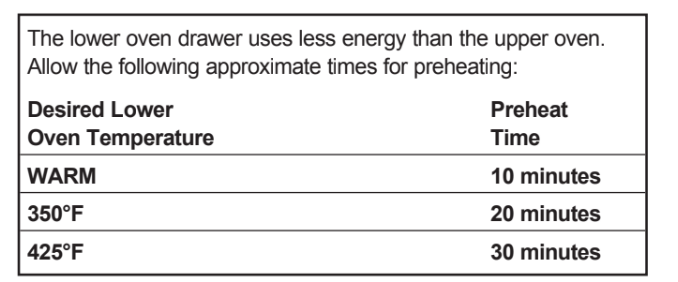
Aluminum Foil and Oven Liners
CAUTION: Do not use any type of foil or oven liner to cover the oven bottom. These items can block airflow or melt, resulting in damage to the product and risk of carbon monoxide poisoning, smoke or fire. Damage from improper use of these items is not covered by the product warranty.
Foil may be used to catch spills by placing a sheet on a lower rack, several inches below the food. Do not use more foil than necessary and never entirely cover an oven rack with aluminum foil. Keep foil at least 1-1/2” from oven walls to prevent poor heat circulation.
CARE AND CLEANING
Oven
Be sure electrical power is off and all surfaces are cool before cleaning any part of the range.
Control Panel and Knobs
Wipe the control panel after each use of the oven with a damp cloth. For cleaning, use mild soap and water or a 50/50 solution of vinegar and water. Rinse with clean water. Polish dry with a soft cloth.
Do not use abrasive cleansers, strong liquid cleansers, plastic scouring pads or oven cleaners on the control panel—they will damage the finish.
Do not try to bend knobs by pulling them up or down or by hanging a towel or other such loads. This can damage the gas valve shaft.
The control knobs may be removed for easier cleaning.
With knobs in the OFF position pull them straight off the stems.
The knobs can be washed by hand with soap and water or in a dishwasher.
Not all knobs are interchangeable. To determine the correct location of a particular knob, examine the back of the knob. A knob with a label or two stem holes should be replaced on the front panel first by matching the shape of the knob holes to the shape of the control panel stems. The remainder of the knobs having no labels and only one stem hole can then be replaced on the front panel anywhere there is a single stem.

Oven Exterior and Cooktop Surface
Do not use oven cleaners, abrasive cleansers, strong liquid cleansers, steel wool, plastic scouring pads, or cleaning powders on the interior or exterior of the oven. Clean with a mild soap and water or a 50/50 solution of vinegar and water. Rinse with clean water and dry with a soft cloth. When cleaning surfaces, make sure that they are at room temperature and not in direct sunlight.
If a stain on the door vent trim is persistent, use a mild abrasive cleaner and a sponge-scrubber for best results.
Spillage of marinades, fruit juices, tomato sauces and basting liquids containing acids may cause discoloration and should be wiped up immediately. Let hot surfaces cool, then clean and rinse.
Stainless Steel Surfaces (on some models)
Do not use a steel wool pad; it will scratch the surface.
To clean the stainless steel surface, use warm sudsy water or a stainless steel cleaner or polish. Always wipe the surface in the direction of the grain. Follow the cleaner instructions for cleaning the stainless steel surface.
Cleaners with oxalic acid such as Bar Keepers Friend Soft Cleanser™ will remove surface rust, tarnish and small blemishes. Use only a liquid cleanser free of grit and rub in the direction of the brush lines with a damp, soft sponge.
To inquire about purchasing cleaning products including stainless steel appliance cleaner or polish, read the Assistance/Accessories sections at the beginning of this manual.
Oven Interior
The interior of your new oven can be cleaned manually or by using the Steam Clean or Self Clean modes.
Spillage of marinades, fruit juices, tomato sauces and basting liquids containing acids may cause discoloration and should be wiped up as soon as hot surfaces cool, then clean and rinse
Manual Cleaning
Do not use oven cleaners, abrasive cleaners, strong liquid cleansers, steel wool, scouring pads, or cleaning powders on the interior of the oven. Clean with a mild soap and water or 50/50 solution of vinegar and water. Rinse with clean water and dry with a soft cloth. When cleaning surfaces, make sure that they are at room temperature and not in direct sunlight.
Oven Interior
Self Clean Mode
Read Self-Cleaning Oven Safety Instructions at the beginning of this manual before using Self Clean Mode. Self clean uses very high temperatures to clean the oven interior. The oven door will lock when using this feature. Before operating the self-clean cycle, pre-wash inner door and inside window before self-cleaning. Wipe inner black door before self clean. Remove all items from the oven other than enameled (dark color) racks. Shiny or silver racks, the meat probe, and any cookware or other items should all be removed from the oven before initiating a self-clean cycle. The surface burners must be turned off prior to the self-clean start time. Cooktop burners will not start during self clean cycle. Close the door. Press the Clean pad once and a default self-clean time is displayed. Press the Start pad or use the number pads to enter any clean time between 3 and 5 hours and press Start. For heavily soiled ovens 5 hours is recommended. The oven will turn off automatically when the self-clean cycle is complete. The door will stay locked until the oven has cooled down. After the oven has cooled down wipe any ash out of the oven.
IMPORTANT: The health of some birds is extremely sensitive to the fumes given off during the self-cleaning cycle of any range. Move birds to another well-ventilated room.
Oven Racks
All oven racks may be cleaned by hand with an abrasive cleaner or steel wool. Black porcelain-coated oven racks may remain in the oven during the self-cleaning cycle without being damaged. If nickel-plated oven racks remain in the oven during the self-cleaning cycle, they will lose their luster and become hard to slide. It will be necessary to grease all oven rack side edges with a light coating of vegetable oil after cleaning them by hand or in the oven. This will help maintain the ease of sliding the racks in and out of the oven.
Probe
The temperature probe may be cleaned with soap and water or a soap-filled scouring pad. Cool the temperature probe before cleaning. Scour stubborn spots with a soap-filled scouring pad, rinse and dry.
To order additional temperature probes read the Assistance and Accessories sections at the beginning of this manual.
- Do not immerse the temperature probe in water.
- Do not store the temperature probe in the oven.
- Do not leave the temperature probe inside the oven during a self or steam clean cycle.
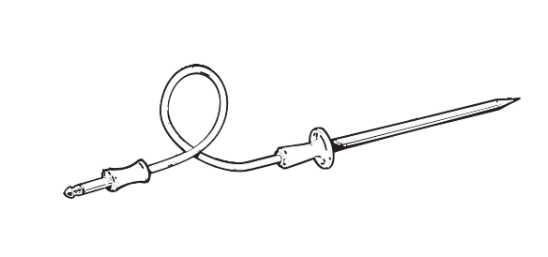
Cooktop
Removal of Surface Burners for Cleaning
Turn all controls OFF. Allow cooktop to cool before removing grates and burner parts. When removing the burner caps and heads, remember their size and location. Replace them in the same location after cleaning.
CAUTION: Do not attempt to remove bridge burner, oval burner or tri-ring burner caps from burner heads.
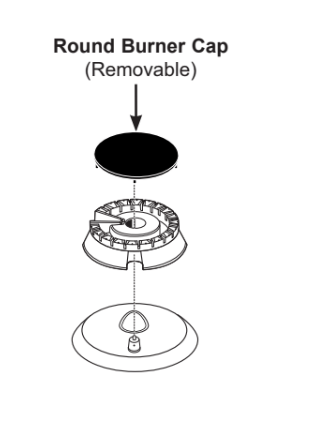
Round Burner
The burner caps and burner heads can be lifted off the cooktop.
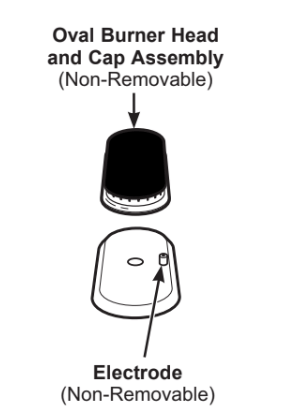
Over Burner Cap ( on some models)
Cap is permanently attached to the burner head.
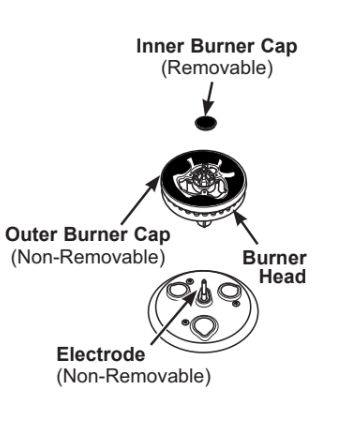
Tri-Ring Burner (on some models)
The small tri-ring burner cap can be lifted off for cleaning. The outer cap is permanently attached to the burner head assembly. Lift the burner head assembly off the cooktop as one piece.
Cleaning The Burners
Burner Caps
Wash burner caps in hot, soapy water and rinse with clean water. You may scour with a plastic scouring pad to remove burned-on food particles. The round caps may also be cleaned in your dishwasher.
Burner Heads
Wash the burner heads routinely, especially after bad spillovers, which could clog the openings. Lift burners off when cool. Use hot, soapy water. Rinse with clean water. For more stubborn stains, use a brush with plastic bristles.
NOTE: Do not use steel wool or scouring powders to clean the burner parts as these may clog the parts.
Never wash burner heads in your dishwasher as dishwasher detergents will discolor your burners.
The ports in the burner heads must be kept clean at all times for an even, unhampered flame.
Clogged or dirty burner ports or electrodes will not allow the burner to operate properly.
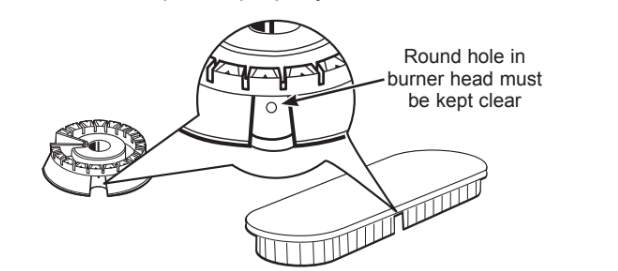
For proper ignition, make sure the small hole in the notch that fits over the electrode is kept open. A sewing needle or wire twist-tie works well to unclog it.
After cleaning
Before putting the burner caps, heads (on some models) and oval head/cap assembly back, shake out excess water and allow them to dry thoroughly.
Replacing Burner Heads
Replace burner heads in the correct locations according to size.
Burner Caps
Replace burner caps on burner heads. Make sure each cap fits securely and sits flat on its corresponding burner head.

CAUTION: Do not operate the cooktop without all burner parts and grates in place.
Any spill on or around an electrode must be carefully cleaned. Take care to not hit an electrode with anything hard or it could be damaged.
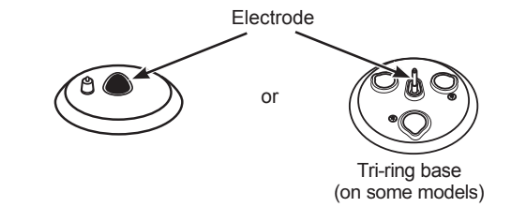
The electrode of the spark igniter is exposed when the burner head is removed. When one burner is turned to LITE, all the burners spark. Do not attempt to disassemble or clean around any burner while another burner is on. An electric shock may result, which could cause you to knock over hot cookware.
Burner Grates
Grates should be washed in hot, soapy water and rinsed with clean water or in the dishwasher. To soften burned-on food, place grates in a plastic bag containing %-cup of household ammonia for several hours. Afterward, scrub grates with a plastic scouring pad soaked in hot, soapy water. Rinse well and dry.
When replacing the grates, be sure to locate them correctly on the cooktop. Grates are identified by the words LEFT and RIGHT on their bottom surfaces. Grate should fit securely into the cooktop.
Grates will gradually lose their shine due to their continual exposure to high temperatures.
Cleaning the Grates in the Self-Clean Oven
If your cooktop grates do not have rubber bumpers on their bottom surface and your oven racks are coated with black porcelain, your grates may be cleaned in the oven using the self-clean cycle. If your grates have rubber bumpers, do not attempt to clean your grates in the oven. Doing so will destroy the rubber bumpers and may affect the function of your surface burners.
Place oven racks in the positions labeled “R”, “2” and “4” in the illustration. Place a single grate on each rack. Follow instructions for the self-clean mode in the Cleaning the Oven section of this manual.
NOTE: Use caution when removing the grates from the oven after the self-clean cycle has ended. The grates may still be hot.
After cleaning, you may notice a white residue on the grates. Wipe it off with a damp sponge. If white spots persist, wet the sponge with a 50/50 solution of vinegar and water.
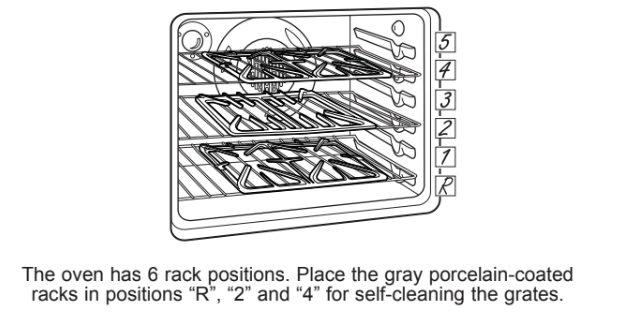
Grate Support Bumpers
If any of the rubber grate support bumpers in the cooktop are missing or damaged, replacement parts can be obtained by calling 1.800.GE.CARES.
To insert the new bumpers, simply place the cone-shaped end of the bumper into the hole in the cooktop and push down while gently twisting the bumper.

Griddles
Griddle Precautions:
If something has spilled under the griddle, it should be cleaned up as soon as possible to prevent the spill from getting baked onto the cooktop.
Do not allow grease to accumulate under the griddle as it can be a fire hazard. Clean under the griddle with hot soapy water as soon as it is cool.
Do not wash your griddle in the dishwasher.
Do not place your griddle in a microwave oven.
Door and Drawer
To clean the inside of the door
Do not allow excess water to run into any holes or slots in the door.
Wipe dishwashing detergent over any baked-on spatters on the glass. Use a single sided safety razor blade to clean it off. Then wipe over the glass with a soapy cloth to remove any residue and dry off.
The area outside the gasket can be cleaned with a soap-filled plastic scouring pad.
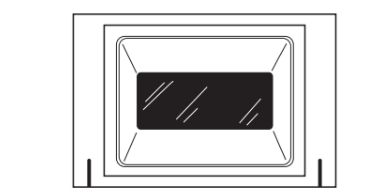
The gasket is designed with a gap at the bottom to allow for proper air circulation.
Do not rub or clean the door gasket—it has an extremely low resistance to abrasion.
If you notice the gasket becoming worn, frayed or damaged in any way or if it has become displaced on the door, you should have it replaced.
Removable Drawer (Lower Oven Drawer Models only)
NOTE: For models with an electric warming drawer or lower oven drawer, before performing any adjustments, cleaning or service, disconnect the range electrical power supply at the household distribution panel by removing the fuse or switching off the circuit breaker. Make sure the warming drawer heating element is cool.
Most cleaning can be done with the drawer in place. However, the drawer may be removed if further cleaning is needed. Use soap and warm water to thoroughly clean.
To replace the drawer:
- Place the left drawer rail around the inner left rail guide and slide it in slightly to hook it.
- Place the right drawer rail around the inner right rail guide and slide it in slightly to hook it.
- Slide the drawer all the way in.
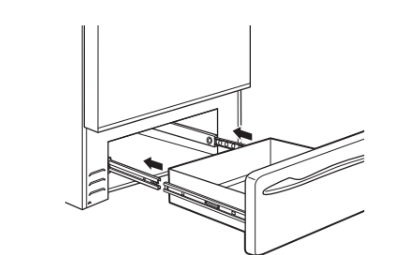
To remove the drawer:
- Pull the drawer straight out until it stops.
- Press the left rail release up and press the right rail release down, while pulling the drawer forward and free

Removable Lower Oven Drawer Pan
NOTE: For models with an electric warming drawer or lower oven drawer, before performing any adjustments, cleaning or service, disconnect the range electrical power supply at the household distribution panel by removing the fuse or switching off the circuit breaker. Make sure the drawer heating element is cool.
NOTE: Allow lower oven drawer to cool before removing pan.
NOTE: Wipe spills promptly after each use.
- Never place, use or self-clean the lower oven drawer pan in the upper oven.
- Lower oven drawer has a removable pan for easy cleaning. Clean with hot soapy water and a sponge or dish towel. Dry with a clean cloth. An oven cleaner, such as Easy-Off®, may also be used. Be sure to follow the directions on the oven cleaner. Replace the pan in the lower oven drawer.
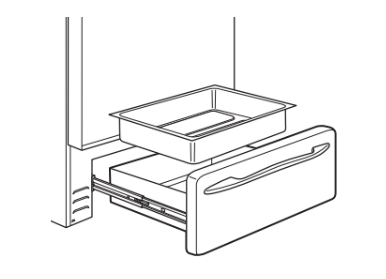
Oven Light
WARNING: SHOCK OR BURN HAZARD: Before replacing oven light bulb, disconnect the electrical power to the oven at the main fuse or circuit breaker panel. Failure to do so may result in electric shock or burn.
CAUTION: BURN HAZARD: The glass cover and bulb should be removed when cool. Touching hot glass with bare hands or a damp cloth can cause burns.
NOTE: The glass cover should be removed only when cold. Wearing latex gloves may offer a better grip.
Before replacing the bulb, disconnect electrical power to the oven at the main fuse or circuit breaker panel. Let the bulb cool completely before removing it. For your safety do not touch a hot bulb with a damp cloth. If you do the bulb may break.
To remove:
Turn the glass cover counterclockwise 1/4 turn until the tabs of the glass cover clear the grooves of the socket. Remove the bulb.
To replace:
Put in a new 40-watt appliance bulb. Place the tabs of the glass cover into the grooves of the socket. Turn the glass cover clockwise 1/4 turn.
NOTE:
- A 40-watt appliance bulb is smaller than a standard 40-watt household bulb.
- Reconnect electrical power to the oven once the new bulb is installed.
- For improved lighting inside the oven, clean the glass cover frequently using a wet cloth. This should be done when the oven is completely cool.
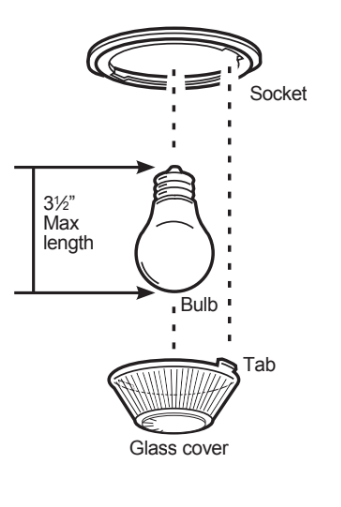
Oven Door
The door is very heavy. Be careful when removing and lifting the door. Do not lift door by the handle.
To Remove the Door:
- Fully open the door.
- Pull the hinge locks up and away from the range frame to the unlocked position.
- Firmly grasp both sides of the door near the top.
- Close door until the top of the door is approximately 6” from the range frame.
- Lift door up and away from the range until both hinge arms are clear of the slots in the range frame.
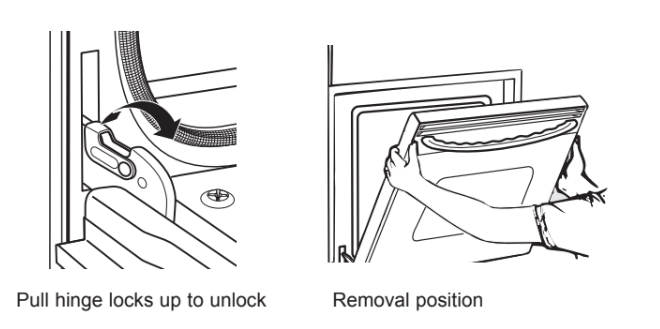
To Replace the Door:
- Firmly grasp both sides of the door near the top.
- With the door at the same angle as the removal position, rest the notch on the underside of the left hinge arm on the bottom edge of the left hinge slot. The notch in the hinge arm must be fully seated into the bottom of the slot. Repeat for the right side.
- Fully open the door. If the door will not fully open, the notches in the bottoms of the hinge arms have not seated correctly in the bottom edge of the slot. Lift the door off the range and repeat previous step.
- Push the hinge locks toward the range cavity and down to the locked position.
- Close the oven door.

Troubleshooting tips ... Before you call for service
Problem | Possible Cause | What To Do |
| My new oven doesn't cook like my old one. Is something wrong with the temperature settings? | Your new oven has a different cooking system from your old oven and therefore may cook differently than your old oven. | For the first few uses, follow your recipe times and temperatures carefully. If you still think your new oven is too hot or too cold, you can adjust the temperature yourself to meet your specific cooking preference |
| Food does not bake or roast (in the upper oven) properly | Oven controls improperly set. | See the Cooking Modes section. |
| Rack position is incorrect or rack is not level. | See the Cooking Modes section and Cooking Guide. | |
| Incorrect cookware or cookware of improper size being used. | See the Cookware section. | |
| Food being cooked in a hot pan. | Make sure cookware is cool. | |
| Cookware not suited for broiling. | Use a pan specifically designed for broiling. | |
| Aluminum foil used on the broiling pan and grid has not been fitted properly and slit as recommended. | If using aluminum foil conform to pan slits. | |
| In some areas the power (voltage) may be low. | Preheat the broil element for 10 minutes. | |
| Upper oven temperature too hot or too cold | Oven temperature needs adjustment. | See the Special Features section. |
| Oven does not work or appears not to work | A fuse in your home may be blown or the circuit breaker tripped. | Replace the fuse or reset the circuit breaker. |
| Oven controls improperly set. | See the Using the Oven section. | |
| Oven is in Sabbath Mode. | Verify, that the oven is not in Sabbath Mode. See the Special Features section. | |
| Heating elements turn off when door is open. | This is normal. | |
| “Crackling” or “popping” sound | This is the sound of the metal heating and cooling during both the cooking and cleaning functions. | This is normal. |
| Why is my range making a "clicking" noise when using my oven? | Your range has been designed to maintain a tighter control over your oven's temperature. You may hear your oven's heating elements "click" on and off more frequently than in older ovens to achieve better results during baking, broiling, and self-clean cycles | This is normal. |
| Clock and timer do not work | A fuse in your home may be blown or the circuit breaker tripped. | Replace the fuse or reset the circuit breaker. |
| Sometimes the oven takes longer to preheat to the same temperature | Cookware or food in oven | The cookware or food in the oven will cause the oven to take longer to preheat. Remove items to reduce preheat time. |
| Number of racks in oven | Adding more racks to the oven will cause the oven to take longer to preheat. Remove some racks | |
| Upper oven light does not work | Light bulb is loose or defective. | Tighten or replace bulb. |
| Pad operating light is broken. | Call for service. | |
| Upper oven will not self-clean | The temperature is too high to set a self-clean operation | Allow the oven to cool and reset the controls. |
| Oven controls improperly set. | See the Cleaning the Oven section. | |
| Excessive smoking during clean cycle | Excessive soil or grease.. | Press the Clear/Off pad. Open the windows to rid the room of smoke. Wait until the LOCKED DOOR light goes off. Wipe up the excess soil and reset the clean cycle. |
| Excessive smoking during broiling | Food too close to burner element. | Lower the rack position of the food. |
| Oven door will not open after a clean cycle | Oven too hot. | Allow the oven to cool below locking temperature. |
| Oven not clean after a clean cycle | Oven controls improperly set. | See the Cleaning the Oven section. |
| Oven was heavily soiled. | Clean up heavy spillovers before starting the clean cycle. Heavily soiled ovens may need to self-clean again or for a longer period of time. | |
| “DOOR LOCK” flashes in the display | The self-clean cycle has been selected but the door is not closed. | Close the oven door. |
| "LOCKED DOOR” light is on when you want to cook | The oven door is locked because the temperature inside the oven has not dropped below the locking temperature | Press the Clear/Off pad. Allow the oven to cool. |
| “F— and a number or letter” flash in the display | You have a function error code. | Press the Clear/Off pad. Allow the oven to cool for one hour. Put the oven back into operation. |
| If the function code repeats. | Disconnect all power to the oven for at least 30 seconds and then reconnect power. If the function error code repeats, call for service | |
| Display goes blank | A fuse in your home may be blown or the circuit breaker tripped. | Replace the fuse or reset the circuit breaker. |
| The clock is turned off. | See the Special features section. | |
| Oven is in Sabbath Mode. | Verify that the oven is not in Sabbath Mode. See the Special Features section. | |
| Power outage, clock flashes | Power outage or surge | Reset the clock. If the oven was in use, you must reset it by pressing the Clear/Off pad, setting the clock and resetting any cooking function |
| “Burning” or “oily” odor emitting from the vent | This is normal in a new oven and will disappear in time | To speed the process, set a self-clean cycle for a minimum of 3 hours. See the Cleaning the Oven section. This is temporary. |
| Strong odor | An odor from the oven insulation is normal for the first few times the oven is used. | This is temporary and will go away after several uses or a self-clean cycle. |
| My oven door glass appears to be "tinted" or have a "rainbow" color. Is this defective? | No. The inner oven glass is coated with a heat barrier to reflect the heat back into the oven to prevent heat loss and keep the outer door cool while baking. | This is normal. Under certain light or angles, you may see this tint or rainbow color. |
| Top burners do not light or do not burn evenly. (The front right burner is designed to have slightly smaller flames between the 6 and 9 o’clock positions. This is normal.) | Plug on range is not completely inserted in the electrical outlet. | Make sure electrical plug is plugged into a live, properly grounded outlet. |
| Burner slits on the side of the burner may be clogged. | Remove the burners and clean them. Check the electrode area for burned-on food or grease. See the Care and cleaning of the range section. | |
| Improper burner assembly.. | Make sure the burner parts are installed correctly. See the Care and cleaning of the range section. | |
| Burner flames very large or yellow | Improper air to gas ratio. | If range is connected to LP gas, contact the person who installed your range or made the conversion. |
| Surface burners light but oven does not | The oven gas shut-off valve may have accidentally been moved during cleaning or moving. | To check the oven gas shut-off vavle, remove the drawer (see the Care and cleaning of the range section). For lower oven drawer models, remove the rear access panel by unscrewing the thumb screws in the upper left and right corners. Look for the gas shut-off lever at the back of the range. 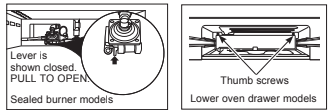 |
| Burners do not light | Plug on range is not completely inserted in the electrical outlet. | Make sure electrical plug is plugged into a live, properly grounded outlet. |
| Gas supply not connected or turned on. | See the Installation Instruction that came with the range | |
| A fuse in your home may be blown or the circuit breaker tripped. | Replace the fuse or reset the circuit breaker. | |
| Burner parts not replaced correctly. | See the Care and Cleaning of the range section. | |
| Lock Controls or Control Lockout feature is activated | If LOC ON appears in the display, the range control is locked. Turn this feature off to use the range. See the Lock Control feature in the Oven Controls section. | |
| Drawer does not slide smoothly or drags | The drawer is out of alignment. | Fully extend the drawer and push it all the way in. See the Care and Cleaning of the range section. |
| Drawer is over-loaded or load is unbalanced. | Reduce weight. Redistribute drawer contents. | |
| Lower Oven drawer will not work | A fuse in your home may be blown or the circuit breaker tripped. | Replace the fuse or reset the circuit breaker. |
| The oven is self-cleaning. | Wait for the self-clean cycle to finish and the oven to cool. | |
| Controls improperly set. | See the Lower Oven Drawer section. | |
| Excessive condensation in the drawer | Liquid in drawer. | Remove liquid. |
| Uncovered foods. | Cover food with lid or aluminum foil. | |
| Temperature setting too high. | Reduce temperature setting. | |
| Food dries out in the lower oven drawer | Moisture escaping. | Cover food with lid or aluminum foil. |
| Drawer not fully closed. | Push drawer in until latch engages. | |
| Control signals after entering cooking time or start time | You forgot to enter a bake temperature or cleaning time. | Touch the Bake pad and desired temperature or the Self Clean pad and desired clean time. |
| "Close Door” scrolls in the display when BROIL is set | The display will always automatically remind you to close the door. | This is a normal reminder to close the door when broiling. |
| "Probe” appears in the display | This is reminding you to enter a probe temperature after plugging in the probe. | Enter a probe temperature. |
| LOC appears in display | The Gas/Control Lockout feature is activated | Be sure the surface burner controls are turned OFF. Turn this feature off to use the range. See the Gas/ Control Lockout section. |
| Fan noise | The convection fan may turn on and off automatically. | This is normal. The convection fan will run until the function is over or the door is opened. |
| Convection fan not working | Preheat temperature not reached. | Fan will start automatically once the preheat temperature is reached. |
See other models: AEZ06LVQ1 PB960EJ2ES GDF620HSJ2SS GLD2800T05WW JVM7195EK2ES
